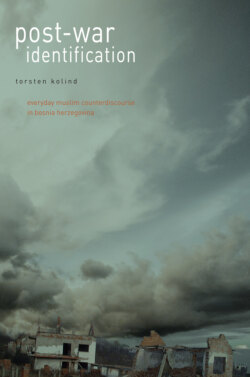Читать книгу Post-War Identification - Torsten Kolind - Страница 18
На сайте Литреса книга снята с продажи.
Expression
ОглавлениеThe next perspective to be found in contemporary anthropology of war and war-related violence focuses on the violent acts themselves, on the meaning they carry and the cultural landscape in which they are shaped and serve as communication. The perspective is based on the implicit assumption that the way in which one dies or is injured is significant and seldom coincidental. The studies grouped together in this second category therefore try to explicate (Geertz 1973) rather than explain violent events; one could say that they make a ‘thick description’ of the violent events.
Van de Port (1998) conducted fieldwork in a Serbian town in Vojvodina. His research was meant to be a study of gypsies, but then the war broke out and left him and seemingly everybody else in a condition of mental and existential chaos. But only seemingly. He discovered the existence of a cultural logic that he, following Taussig, calls implicit social knowledge, which was used to make sense of the madness of the war. This knowledge, which was neither conscious nor verbalised, was for instance manifested in the Serbs’ ambivalent relationship to the gypsies. On the surface, the Serbs condemned the gypsies as uncivilised primitives, but below the surface the Serbs embraced the primitive, uncivilised, emotional craziness that they felt the gypsies represented. So in everyday life the ‘civilised’ Serbian citizens of Vojvodina showed distaste for the war-related barbaric and insane violence; but at night in the gypsy bars they embraced it because of the connection they felt with the implicit social knowledge which the gypsies embodied. Other studies have focused more on the violent acts themselves and shown how they can be loaded with cultural meaning (Feldman 1991; Krohn-Hansen 1997b). Malkki (1998), for instance, analyses the Tutsis’ bestial, violent acts against the Hutus as attempts to dehumanise the Hutus, to associate them with nature and disassociate them from culture. And Olujic (1998) argues that war rapes in former Yugoslavia were not only physical assaults on the women, but also attacks on the male members of their family, whose honour was related to the female members’ chastity. The individual body becomes in this way a metaphorical representative of the social body, and the killing or maiming of that body symbolically kills and maims the individual’s family and ethnic group. The war rapes also reinforced the cultural notions of cleanliness and dirtiness associated with sexuality and ethnic affiliation. Through forced pregnancy resulting from rape, aggressors could ‘purify the blood’ of the attacked group by creating ‘ethnically cleansed’ babies belonging to the group of the invading fathers. On quite a different scale, Appadurai (1999) tries to understand contemporary ethnic atrocities worldwide in relation to a culture of modernity. Modernity and globalisation, he claims, have disembedded social relations and created uncertain and alienated identities. Violence thus uses the body to recreate certainty and intimacy in a grotesque way.3
Anthropological studies of violence that focus on expression and meaning try to understand the cultural anchoring of violent acts and how violence functions as communication. And sometimes such insight is used to explain the potential instrumentality of violence. A major challenge confronting anthropological studies of the expressive character of violence is to consider the ethical dimension thoroughly (see, for instance, Richard Jenkins’ (1992) critique of Allen Feldman). In short, it is essential not to let the act of interpretation overshadow the experience of violence.
